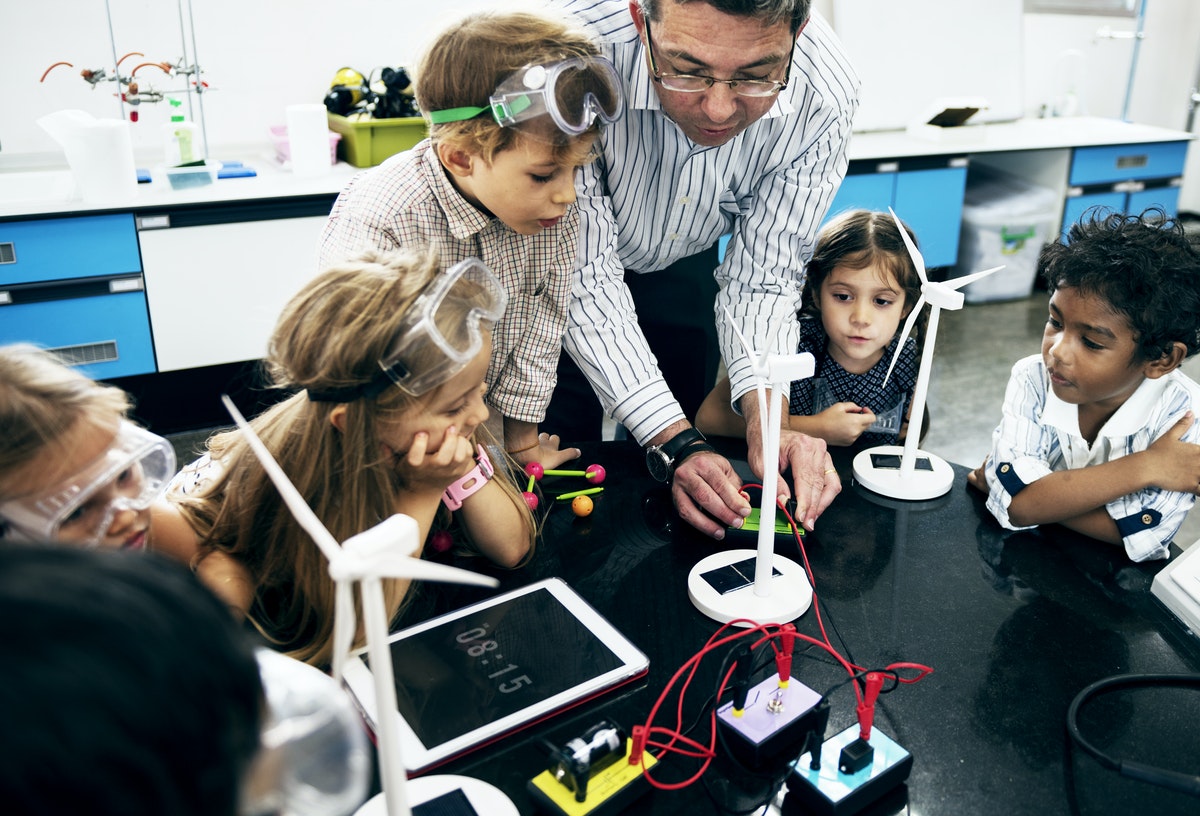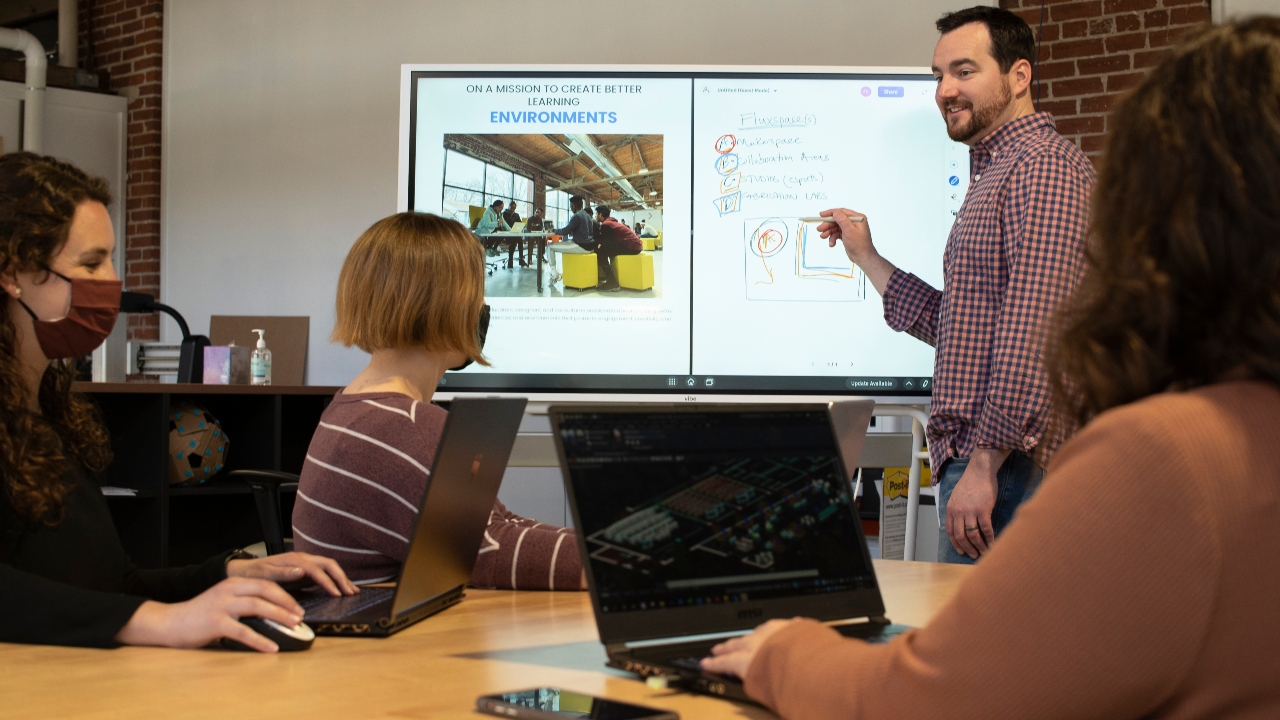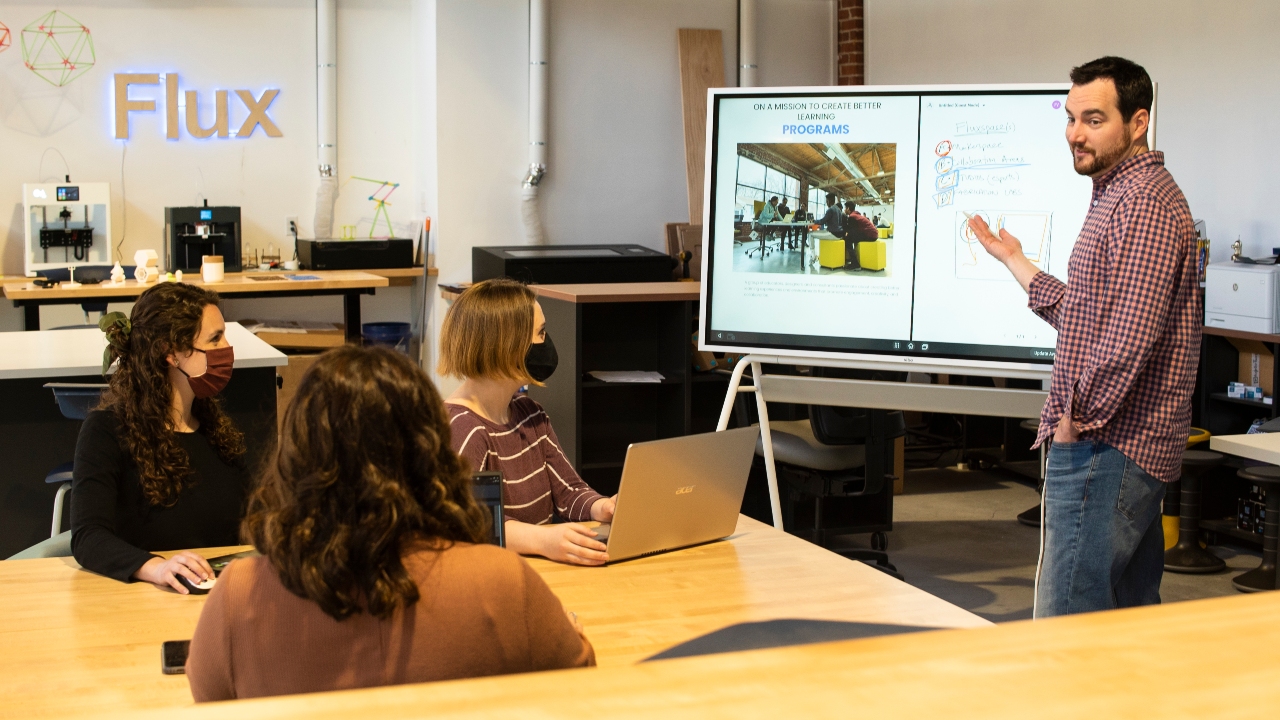Have you ever noticed that you’re more productive in a certain room or building? Maybe you’re drawn to the configuration of furniture, the technology available, or even the general culture of the space. Whatever the reason, the way we think, feel, and act has a lot to do with the environment we’re in. A creative workspace can inspire some of your best work.
Schools and organizations have come to recognize the value of collaborative spaces and have turned to professionals to help improve their workspaces. Ryne Anthony, Director of Innovation at Fluxspace, is an expert at creating innovative spaces that take learning and collaboration to the next level. In this post, Anthony shares the proven practices educators and professionals need to build an environment where enriching experiences can flourish.
The 3 pillars of every successful collaborative space
Group activities shouldn’t be complicated, and neither should the components of a collaborative space. There are three simple elements that every organization can implement. Anthony explains, “All these three things need to be balanced really well to achieve a new type of learning style or environment.”
The physical space
When redesigning a classroom or creative workspace, flexibility is the name of the game. A flexible environment allows users to reconfigure the space to accommodate a wide range of group activities and learning experiences. Rooms should be equipped with mobile furniture and technology that can be reconfigured for easy collaboration.
Of course, the actual size of a room could be a barrier to change. But before you jump to the conclusion that your space is unfit for this kind of flexibility, consider how your real estate is being utilized (and by whom).
“The teacher’s desk and space in the classroom occupy nearly a third of the learning space,” says Anthony. A well-designed collaborative space shouldn’t feel like there’s an established “front” of the classroom or workspace. “By cutting down on that space, you can dedicate more space to the people who need it the most.” Give students an environment where elevated hands-on learning is possible.
The right technology and tools
Technology bolted to a wall, consequently, keeps students bolted to their seats. Experiential learning environments require free movement and adaptability, so mobile technology is the best fit. Virtual whiteboards have become an integral part of a collaborative space.
“Now, with the innovation of the Vibe Board, the front of the classroom could be anywhere,” explains Anthony. With Vibe’s portable stand and real-time editing capabilities on the board, or a laptop or tablet, education can take place wherever it’s best for the student.
“It’s a product that you don’t need to be tethered to, and you can easily wirelessly connect to it as a student or teacher,” explains Anthony. “It helps facilitate what 21st-century learning should be in terms of streamlining the process of people being able to connect to a device.”
The programs you use in a classroom are just as important as the technology. That’s why Vibe has over 80 integrated apps to help facilitate the best learning. Remote teachers will especially love the ability to use a virtual whiteboard during a Zoom call or other video conferencing.
{{<blog/cta-1 “Vibe Interactive Whiteboard for Distance Learning” “https://vibe.us/lp/scenario-education/” >}}
A creative workspace requires a change in focus
You can have all the right furniture, tools, and technology needed for a collaborative environment, but it will amount to nothing if you don’t have the right approach and mindset to collaboration. In an educational space, the focus should be on the students and their learning.
Anthony sums up this concept, “The idea is moving to student-centered learning where students know how to access information quickly, and with that information, they know how to apply it to solve a problem. The whole physical classroom needs to make sure that we’re promoting this mindset.”
Work shouldn’t just keep kids busy. It should be intentional and provide an opportunity for them to collaborate and create. Ensure that the practices and activities you carry out allow students to be hands-on and present in their education. Several teachers have turned to STEAM projects to accomplish this.
Above all, help students feel safe to share their ideas. Foster an environment where the classic “there’s no such thing as a dumb question” ideology rules the roost. This, combined with a focus on student-centered learning, creates a culture where students thrive.

How a collaborative space makes all the difference
There is so much good that comes from an environment where its inhabitants can freely share and grow together. Here are some of the perks that come with this unique territory:
Educators become facilitators rather than lecturers
“I’m not trying to make students compliant; I’m trying to make them engaged,” says Anthony. Time that was once spent disciplining and trying to keep order in a classroom is better spent engaging students with hands-on activities.
“When students are engaged and having fun and coming up with really cool ideas or they’re excited about the work that they’re doing, that’s the most rewarding and fulfilling part for a teacher.” A collaborative learning space has a way of transforming teachers from lecturers to facilitators.
Maximize brain power and overall happiness
Educational studies show that hands-on learning improves retention, attentiveness, and helps students take greater pride in their work. Having a space where this kind of learning is the norm for students will help them better absorb and enjoy the curriculum.
Just as a space’s activities improve students’ capacity to learn, studies also indicate that the overall design and layout of a workspace plays an important role in employee health and well-being. When you build a space that has the right flexibility, tools, and focus, you build better students and employees.
Prepare students for the workplace
Teachers may roll their eyes when students ask, “When am I ever going to use this?” But, maybe we should take this cue from students more seriously.
“They’re honestly asking the right question,” explains Anthony. “If we, as educators, don’t have an answer for that, maybe we should change up what we’re doing.”
The education that goes on in a collaborative space should be applicable to the real world and help prepare students for their future careers.
“What if we don’t necessarily teach students to take a test, but we teach them for their future? We try to help them get into a career. The more that we can help them find and discover passions and the skills needed to live that passion and turn that into a career, the better off we are.”
Experiences in the classroom translate to better communities
What happens in the classroom shouldn’t just stay in the classroom. Students have an opportunity to use the skills they’re learning to transform their communities.
“Let’s have the school serve the community, not the community serve the school,” Anthony says. “I don’t think we realize that that’s what students benefit most from, is getting that hands-on experience of having an impact.”
Fluxspace has helped students experience this by introducing innovative tools like the Fork Farms hydroponics kit. This unique vertical farming technology has helped students feed their communities, while simultaneously nurturing their minds.
“Students want to give back to their community. They just need to see some products, programs, and options for that to happen,” says Anthony.
Related: How to Set Up a Hybrid Classroom
Optimizing your creative workspace for collaboration
Social distancing doesn’t mean that we need to give up our right to be social. Although no learning or work experience looks the same these days, there are many ways to incorporate healthy collaboration with others into our experiences.
At school:
“I think we’re starting to value when a student is physically sitting in a space and recognize the need to be more intentional about how we’re using that time,” says Anthony.
Schools have rolled out a hybrid approach to education that combines remote and in-person learning. In this case, it’s essential that educators make the most of in-person learning time by ensuring that it’s hands-on (in a socially distant way). Reserve remote days for notetaking and more lecture-based curriculum.
Anthony invites educators to consider, “How can we be a little bit more intentional about not just giving kids busy work after the pandemic, but more of an opportunity to collaborate and be creative when they’re in the seats working together?”

In the workplace:
Since the pandemic, workers have learned several strategies to work from home more effectively. But group collaboration is still an area where there is room for improvement.
“I think in the business place, and especially working from home, make sure that you’re leveraging the tools and technology you have access to as best as you can,” says Anthony.
To take advantage of your resources, Anthony recommends reviewing things like, “How do we use features in Zoom? What video platform works best for my organization? What other products are out there that will make me feel like I’m at an office with other individuals, so my productivity is boosted?”
As employees tap into the many remote collaboration tools now available, the experiences they share with colleagues through a virtual space can be more productive and meaningful.
Related: How to Build a Collaborative Workspace (And Why You Should)
A collaborative space that goes where you go
Whether you’re in a classroom, office, or at home, you have the power to join forces with others successfully. When you have a flexible space, the right technology, and a collaborative culture, creativity is ready to flow. Vibe has the tools and resources you need to bring remote collaboration to life while enhancing in-person discussions. Learn how over 5,000+ companies are using Vibe’s interactive whiteboards and software to make powerful connections worldwide.
Vibe offers a collaborative solution combining an interactive digital whiteboard and innovative smart software. Increase engagement and efficiency at your brainstorming sessions, virtual training, and classroom sessions by integrating your favorite applications with video conferencing and an infinite, mess-free writing canvas. Collaborate today with Vibe.
Looking for the latest in interactive whiteboard technology? Check out Vibe today!
